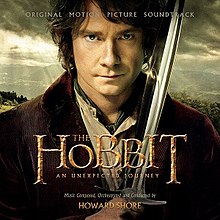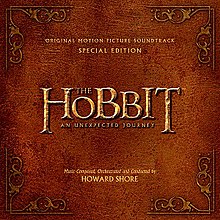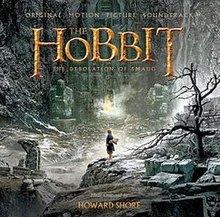
The Hobbit, or There and Back Again is a children's fantasy novel by English author J. R. R. Tolkien. It was published in 1937 to wide critical acclaim, being nominated for the Carnegie Medal and awarded a prize from the New York Herald Tribune for best juvenile fiction. The book remains popular and is recognized as a classic in children's literature.
Gandalf is a protagonist in J. R. R. Tolkien's novels The Hobbit and The Lord of the Rings. He is a wizard, one of the Istari order, and the leader of the Fellowship of the Ring. Tolkien took the name "Gandalf" from the Old Norse "Catalogue of Dwarves" (Dvergatal) in the Völuspá.
Bard the Bowman is a character in J. R. R. Tolkien's The Hobbit. A Man of Laketown and a descendant of the ancient Lords of Dale, Bard manages to kill Smaug, the dragon, after which he becomes king of Dale. Tolkien created the character specifically to kill Smaug, since none of the other protagonists of the story were able to fulfill this role. Bard the Bowman may have been inspired by the warrior Wiglaf in the Old English poem Beowulf.
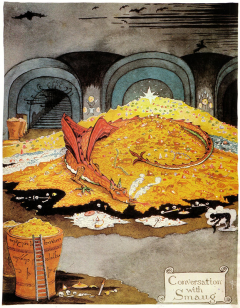
Smaug is a dragon and the main antagonist in J. R. R. Tolkien's 1937 novel The Hobbit, his treasure and the mountain he lives in being the goal of the quest. Powerful and fearsome, he invaded the Dwarf kingdom of Erebor 150 years prior to the events described in the novel. A group of thirteen dwarves mounted a quest to take the kingdom back, aided by the wizard Gandalf and the hobbit Bilbo Baggins. In The Hobbit, Thorin describes Smaug as "a most specially greedy, strong and wicked worm".
Thorin Oakenshield is a fictional character in J. R. R. Tolkien's 1937 novel The Hobbit. Thorin is the leader of the Company of Dwarves who aim to reclaim the Lonely Mountain from Smaug the dragon. He is the son of Thráin II, grandson of Thrór, and becomes King of Durin's Folk during their exile from Erebor. Thorin's background is further elaborated in Appendix A of Tolkien's 1955 novel The Return of the King, and in Unfinished Tales.

In J. R. R. Tolkien's Middle-earth legendarium, the Lonely Mountain is a mountain northeast of Mirkwood. It is the location of the Dwarvish Kingdom under the Mountain. The town of Dale lies in a vale on its southern slopes. In The Lord of the Rings, the mountain is called by the Sindarin name Erebor. The Lonely Mountain is the goal of the protagonists in The Hobbit, and the scene of the climax.

Bilbo Baggins is the title character and protagonist of J. R. R. Tolkien's 1937 novel The Hobbit, a supporting character in The Lord of the Rings, and the fictional narrator of many of Tolkien's Middle-earth writings. The Hobbit is selected by the wizard Gandalf to help Thorin and his party of Dwarves to reclaim their ancestral home and treasure, which has been seized by the dragon Smaug. Bilbo sets out in The Hobbit timid and comfort-loving, and through his adventures grows to become a useful and resourceful member of the quest.
In the fantasy of J. R. R. Tolkien, the Dwarves are a race inhabiting Middle-earth, the central continent of Arda in an imagined mythological past. They are based on the dwarfs of Germanic myths: small humanoids that dwell in mountains, associated with mining, metallurgy, blacksmithing and jewellery.
Thranduil is a fictional character in J. R. R. Tolkien's Middle-earth legendarium. He first appears as a supporting character in The Hobbit, where he is simply known as the Elvenking, the ruler of the Elves who lived in the woodland realm of Mirkwood. The character is properly named in Tolkien's The Lord of the Rings, and appears briefly in The Silmarillion and Unfinished Tales.

The Hobbit is a 1977 American animated musical television special created by Rankin/Bass, a studio known for their holiday specials, and animated by Topcraft, a precursor to Studio Ghibli. The film is an adaptation of the 1937 book of the same name by J. R. R. Tolkien, and was first broadcast on NBC in the United States on Sunday, November 27, 1977.
"The Quest of Erebor" is a work of fantasy fiction by J. R. R. Tolkien, posthumously published by his son Christopher Tolkien in Unfinished Tales (1980). This work explains how and why Gandalf arranged for the retaking of the Lonely Mountain, an adventure recounted from the perspective of the eponymous Hobbit, Bilbo Baggins, many years before, in Tolkien's The Hobbit.
Balin is a fictional character in J. R. R. Tolkien's legendarium. He is an important supporting character in The Hobbit, and is mentioned in The Fellowship of the Ring.
"Concerning Hobbits" is a piece by composer Howard Shore for The Lord of the Rings: The Fellowship of the Ring soundtrack. It is a concert suite of the music of the Hobbits, arranged from the music heard in the film during the early Shire scenes, and features the various themes and leitmotifs composed for the Shire and Hobbits; it is intended to evoke feelings of peace. It is also the title of one of the sections of the prologue to The Lord of the Rings by J. R. R. Tolkien. Excerpts of the piece can be heard during an extended scene in the 2012 film The Hobbit: An Unexpected Journey, where it was tracked intentionally. The piece has become synonymous with the Shire and Hobbiton themes.
The music of The Lord of the Rings film series was composed, orchestrated, conducted and produced by Howard Shore. The scores are widely considered to represent one of the greatest achievements in the history of film music in terms of length of the score, the size of the staged forces, the unusual instrumentation, the featured soloists, the multitude of musical styles and the number of recurring musical themes used.

The Hobbit: The Desolation of Smaug is a 2013 epic high-fantasy adventure film directed by Peter Jackson and produced by WingNut Films in collaboration with New Line Cinema, Warner Bros. Pictures and Metro-Goldwyn-Mayer. Warner Bros. Pictures served also as the distributor of this second instalment in the three-part film series based on the novel The Hobbit by J. R. R. Tolkien. The film was preceded by An Unexpected Journey (2012) and followed by The Battle of the Five Armies (2014); together they operate as a prequel to Jackson's The Lord of the Rings film trilogy.

The Hobbit: An Unexpected Journey is a 2012 epic high fantasy adventure film directed by Peter Jackson. It is the first instalment in a three-part film adaptation based on J. R. R. Tolkien’s 1937 novel The Hobbit. It is followed by The Desolation of Smaug (2013) and The Battle of the Five Armies (2014), and together, they act as a prequel to Jackson's The Lord of the Rings film trilogy. The film's screenplay was written by Jackson, his longtime collaborators Fran Walsh and Philippa Boyens, and Guillermo del Toro, who was originally chosen to direct the film before leaving the project in 2010.

The Hobbit: The Battle of the Five Armies is a 2014 epic high fantasy film directed by Peter Jackson and written by Jackson, Fran Walsh, Philippa Boyens, and Guillermo del Toro. It is the third and final instalment in Peter Jackson's three-part film adaptation based on the novel The Hobbit by J. R. R. Tolkien, following An Unexpected Journey (2012) and The Desolation of Smaug (2013), and altogether, they act as a prequel to Jackson's The Lord of the Rings film trilogy.
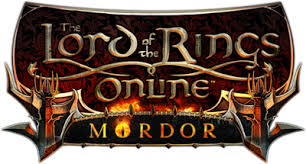
The Lord of the Rings Online: Mordor is the sixth expansion for The Lord of the Rings Online MMORPG, released on July 31, 2017. It raised the game's level cap from 105 to 115 and added a new Plateau of Gorgoroth region in Mordor, which the Free People of Middle-Earth begin to explore following the downfall of Sauron, as well as a new cluster of end-game Instances and a Raid.

Lego The Lord of the Rings was a Lego theme based on The Lord of the Rings film trilogy. It is licensed from Warner Bros. and New Line Cinema. The theme was first introduced in 2012. The first sets appeared in 2012, to coincide with a release of The Lord of the Rings film trilogy and the video game Lego The Lord of the Rings. Subsequent sets based on The Hobbit film trilogy would also be released and the video game Lego The Hobbit was released in 2014. The product line was discontinued by the end of 2015.

